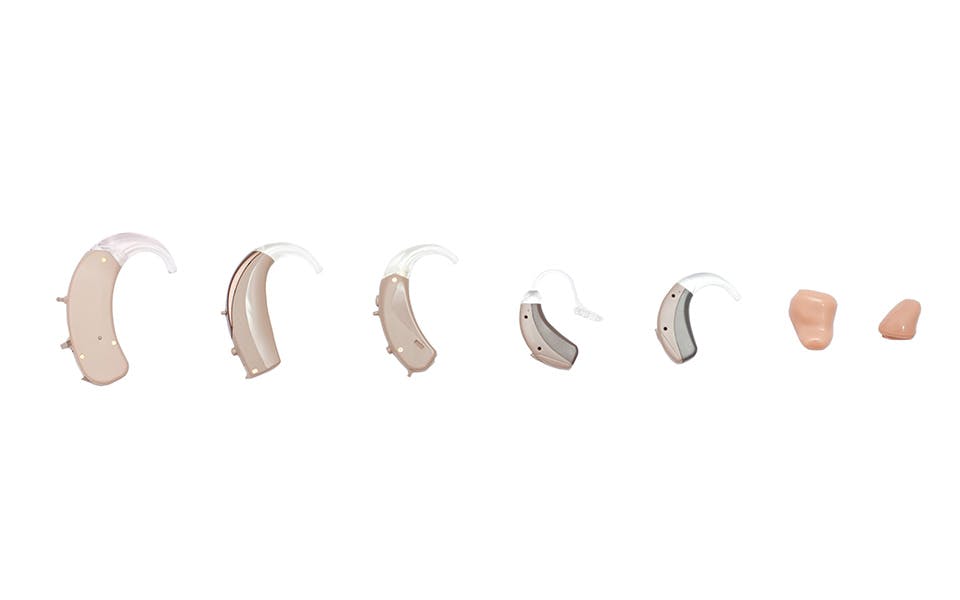In-the-ear (ITE) and behind-the-ear (BTE) devices are different hearing aid styles designed with your specific hearing needs in mind.
What Are ITE Hearing Aids?
ITE devices sit in the shell of your outer ear. They are available in full-shell and half-shell models and are made to fit your unique ear shape.
These hearing aids contain mics, amplifiers and receivers to increase volume and clarify audio quality before sending it to your ears. They have two directional mics to optimize sound localization.
There are other types of hearing aids that fall under the ITE category, including mic-in-helix (MIH), in-the-canal (ITC), completely-in-the-canal (CIC) and invisible-in-the-canal (IIC).
Benefits of Wearing ITE Hearing Aids
Longevity: ITE hearing aids last up to seven to nine years before they need to be replaced.
Battery options: Despite their small size, ITE devices have powerful hearing aid batteries that are available in disposable and rechargeable versions.
Comfort: The custom design allows ITE hearings to fit snuggly in your ears. They’re also a good option if you wear glasses or a nasal cannula for oxygen.
Discretion: These hearing aids sit flush against your outer ear, so they’re easily hidden.
Who Should Wear ITE Hearing Aids?
These hearing aids are suitable for mild to severe hearing loss. They’re discreet and compact if you’re concerned about cosmetic appearances.
ITE hearing aids offer quality amplification, and some models have telecoil and Bluetooth features that allow you to wirelessly connect to compatible technology. Their durable structure makes them compatible with active lifestyles.
Due to their size, ITE models may be difficult to handle if you have limited dexterity. They also require regular cleaning as they’re prone to earwax buildup.
What Are BTE Hearing Aids?
There are several components to BTE hearing aids. The mics, receivers and amplifiers are housed in a case that sits behind your outer ear. A thin plastic tube or wire connects the outer processor to an earpiece that directs sound into your ear.
BTE hearing aid styles include mini BTE, receiver-in-the-canal (RIC), mini receiver-in-the-ear (miniRITE), receiver-in-the-canal (RIC), Super Power (SP BTE) and Power Plus (PP BTE) and Ultra Power (UP BTE).
Each style has a different placement and battery size and takes up varying space behind your ear and in your canal.
Types of BTE Devices
Close fit: This hearing aid has an earmold that completely covers your ear canal to minimize whistling.
Open fit: Open-fit devices are connected to a dome in your ear canal via a thin wire. This style is less likely to create a sense of fullness in your ear that may occur while wearing earmolds.
Advantages of Using BTE Hearing Aids
Handling: BTE models are the largest hearing aids, so they’re a good choice if you struggle to manage small objects. The tubing and earmolds are easy to take apart, clean and reconnect.
Features: The size of the outer component allows for more features and settings to create an advanced listening experience.
Battery life: A larger battery means you can use your BTE devices for extended periods before you have to exchange them. There are also rechargeable hearing aid options.
Customizable: Settings can be adjusted over time to suit your changing hearing needs. The earmolds are also crafted to fit comfortably in your ears.
Who Should Wear BTE Hearing Aids?
This hearing aid is versatile and addresses mild to profound hearing loss. BTE hearing devices provide powerful sound enhancement that’s catered to your degree and type of hearing loss. Their size makes them easy to manage, especially if you’re caring for a loved one with hearing loss.
BTE hearing aids may be problematic if you wear glasses, as the outer component can get in the way of glasses. You might also be uncomfortable if you have small ear canals.
You’ll find a wide variety of ITE and BTE devices from different hearing aid brands at Hearing Associates. We will work closely with you to define your hearing, budgetary and lifestyle requirements to find the best option for you.
Call 888-760-2032 or contact us online to schedule your appointment.


